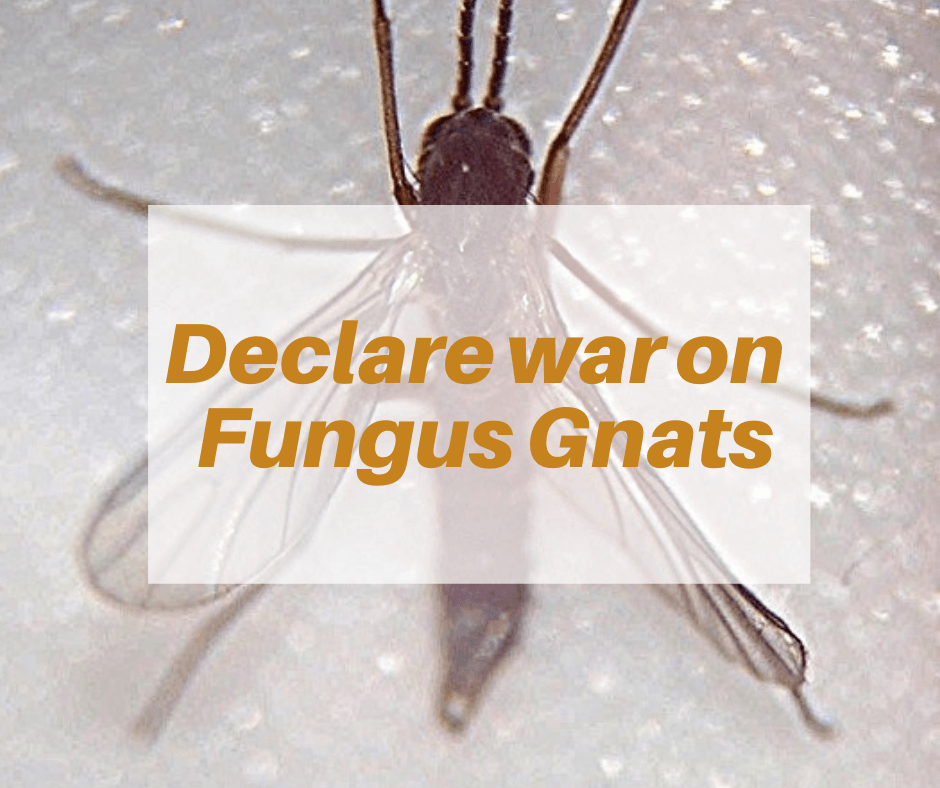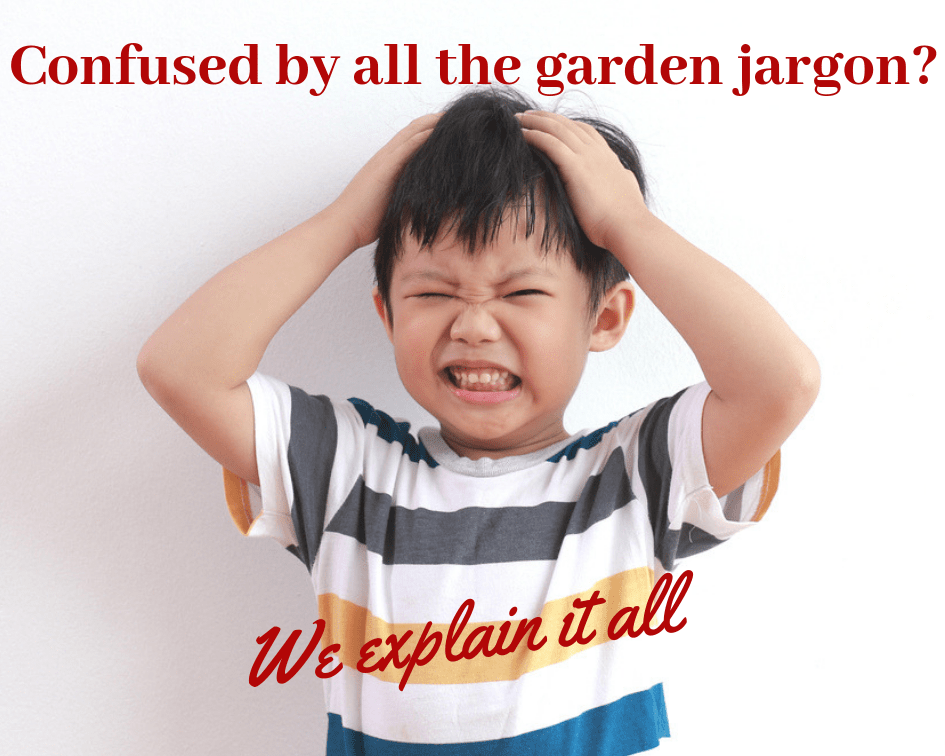This post may contain affiliate links. As an Amazon Associate we earn from qualifying purchases.
Get rid of fungus gnats easily. We show you how.
Outdoor gardeners expect that pests will pay a visit to their crops or ornamentals. Indoor gardeners, on the other hand, don’t. I mean, why do these little critters, with so much to eat outside, want to come inside and how do they get in the house?
Although houseplant moms and dads battle everything from the ubiquitous aphid to mealy bugs, spider mites and more, the most common plea for help that we receive is for getting rid of fungus gnats (Bradysia species).
And, yes, we’ve heard just about every homemade, DIY remedy out there. Don’t know where people come up with these absolutely useless “pesticides,” but they proliferate on amateur gardening sites and YouTube videos, Facebook houseplant groups and even on several university websites.
What amazes us more is that these indoor gardeners think nothing of using these concoctions on their precious — often rare and expensive — houseplants, on the advice of some random person on Facebook or Youtube.
So, how do you get rid of those creepy hordes of fungus gnats? Read on.
Oh, and by the way, we don’t believe in making a promise at a blog post’s outset and then making you read through a bunch of other fluff before fulfilling the promise.
So, if you want to know more about the fungus gnat, like it’s life cycle and more, check out the various university websites – they’re loaded with that type of information.
Right now, however, we have a promise to keep.

Use one of two products and you’re done with fungus gnats
The two best ways to kill fungus gnats on houseplants are also the most organic and non-toxic and, naturally, the most expensive. Isn’t that usually the case?
There is one other way to get to the destructive larvae in the soil that costs a bit less: an insecticidal soil drench. But these contain chemicals that most of us don’t want floating around the interior of our homes or at the availability to our kids and pets.
If you don’t mind chemicals, find a soil drench that has any of the following as an active ingredient:
Follow ALL precautions on the label and use only as instructed. See the section at the end of this post for our precautions.
Now, the two best ways to kill fungus gnat larvae on houseplants that we referred to earlier include:
- Adding Steinernema feltiae, a beneficial nematode, to the soil.
- Using a biological insecticide that includes Bti, short for Bacillus thuringiensis israelensis, a bacterium.
Fungus gnat larvae exposed to the beneficial nematodes die a gruesome death. We’ll let the entomology specialists at Colorado and Kansas State Universities explain:
“Insect parasitic nematodes are microscopic roundworms that enter fungus gnat larvae through natural openings such as the mouth, anus and breathing pores,” they say, sounding very much like the plot of a del Toro movie.
“The nematodes emit a bacterium that digests the internal contents of the larvae. Fungus gnat larvae die within three to four days,” they conclude.
“Good,” we say.
Refrigerate the nematodes to keep them alive until you’re ready to use them.
Then, there’s Bti, the bacterium. While there are different strains of the Bacillus bacterium, the thuringiensis (with the serotype israelensis) is the one you want for getting rid of fungus gnats on houseplants. Read labels carefully because Bt is pest-specific. So, the watchword for this one is “israelensis.”
“Bti has to be eaten to cause mortality,” according to the experts at the University of California, San Diego.
Once the pests ingest it, the bacterium’s toxin dissolves in its gut and attacks the cells, “punching holes in the lining” of the gut. Here’s the money shot though (man, have I bought into the gore!)
“The Bti spores spill out of the gut and germinate inside the insect causing death within a couple days.”
So, where do I find these plant-saving heroes?
Amazon.com, naturally, has folks who sell both the nematodes and the bacterium. Again, you need to read the listings carefully to ensure you’re getting the correct species/strain of Bt (the bacteria).
For instance, on Amazon.com you’ll find pesticides labeled “Bt.” One, from Bonide, contains the kurstaki strain. If you have caterpillars in your plants, use this but it won’t do anything to kill fungus gnats. Remember, these bacteria are pest-specific.
The other Bt comes from Captain Jack. It, too, is not the correct one.
The bacterium, Bt, comes in a variety of forms, one of them is marketed to kill mosquitos, called Mosquito Bits. The label claims that you can spread bits on top of the soil and water in, but users often complain that the bits tend to get moldy. Try making a water solution out of them – that seems to cure the mold problem.
The least expensive package of Mosquito Bits we could find, as of this writing, is at Amazon, especially if you have Prime and don’t have to pay for shipping.
Then, check the seller’s ratings. Both of these products require that the little buggers make it through the mail to your home ALIVE. Not all sellers are good at the shipping process for live organisms.
I like Arbico Organics. Yes, they’re expensive, but I’ve found they’re worth the price in both product and service.
Find the nematodes, private labeled as NemAttack, here. Five million of them for $36. Maybe you have a plant-growing buddy who is also battling fungus gnats? Go in halvers on these.
Neither the bacterium nor the nematodes are harmful to pets and humans.
Prevent fungus gnat infestations
None of the scientists who write about preventing fungus gnat infestations say why, but the female is particularly attracted to peat moss. Or so some of them claim. In reality, recent studies show that fungus gnats aren’t attracted to any particular potting medium. The volume of larvae found, however, does vary according to potting medium and there are more larvae in peat based mixes.
Obviously, you may want to rethink the use of peat moss in your potting soil. Although it’s not a like-kind substitution, coconut coir could replace it. Just use less of it than you would peat moss and watch for calcium deficiency in your plants. Here are a few more tips to prevent a fungus gnat invasion:
- Dry soil also discourages fungus gnats. The females typically lay their eggs in the top 2 to 3 inches of the soil so the roots shouldn’t be harmed by allowing the soil to dry to this depth. Even allowing just the top inch to dry may discourage fungus gnats.
- Keep the top of the soil free of organic debris, such as fallen leaves. Fungus gnats are attracted to anything organic in or on the soil.
- Don’t allow water to sit. Drain your pots, empty the trays beneath them. Keep everything as dry as possible.
Neem oil and insecticidal soap? More trouble than they are worth
Neem is the common name of a tree, Azadirachta indica. Native to the dry tropical areas of Indian, Sri Lanka and Burma, each fruit of the tree bears only one seed. And, although most parts of the tree have a useful (to us) purpose, it’s the seed that provides the pesticide known as “neem oil.”
You’ll hear lots of advice from amateur gardeners about neem’s greatness against fungus gnats. Smile nicely, thank them and move on. But don’t bother following the advice, and here’s why: Neem oil is primarily a contact insecticide, meaning, you need to spray it directly on the pest for it to work.
Fungus gnats fly – spraying them is an exercise in futility. And, since the larvae are in the soil, you’d need to use the oil as a soil drench.
Alas, neem oil is non-persistent, meaning it doesn’t hang around for long, so for effective relief from fungus gnats you’ll need to re-drench the soil every two to three days. Not only is this time consuming (especially if you’re a fellow plant hoarder) but it can get expensive as well.
Do yourself a favor and save the neem oil for mealy bugs and spider mites.
No sand, no peroxide, no vinegar, no b.s.
“Add a 1/4 inch of sand to the top of the soil in your containers to help discourage fungus gnats from laying eggs around the plants.”
How many times have you heard some variation of this advice? If it isn’t sand they’re recommending, it’s diatomaceous earth, or DE.
Has everyone forgotten playing in the sand at the beach? What happens to your sand castle after it sits for a while? If the waves don’t demolish it, it starts cracking. Cracks and fissures are exactly what the female fungus gnat looks for – the ideal baby birthing situation.
Two Kansas State University researchers have studied the use of both dry and moist DE to discourage fungus gnats and found “… the dry or moist layers of diatomaceous earth, in general, did not affect fungus gnats in terms of preventing adult emergence or egg laying by the females.”
In fact, the dry diatomaceous earth created increased fissures, which actually attracted the females to the soil. Then there’s the spraying of all kinds of household items on the soil. Here are a few of the suggestions from the plant “experts” in a Facebook group:
Then there’s the spraying of all kinds of household items on the soil. Here are a few of the suggestions from the plant “experts” in a Facebook group:
- “1-part hydrogen peroxide to 4 parts water when you water the plants.” (peroxide kills bacteria, not insects)
- “… vinegar and soapy water in a spray bottle.” (vinegar is an herbicide, it can kill plants)
- “Dawn dish soap and a little bit of apple cider vinegar on a small dish. Mix it together.”
ARG! Can we quit with the Dawn dish soap myth? It’s NOT a soap, it’s a detergent and it’s full of chemicals. Besides, if it removes crude oil from the feathers of waterfowl, do you really want to use it on your plants?
And vinegar. You’ll find DIYers all over the internet swearing that vinegar is an herbicide and kills weeds. It doesn’t, by the way, unless it’s horticultural vinegar (which is stronger than Round Up).
It does often kill the weed’s foliage, but the roots remain intact. You want to use that on your precious houseplants?
Kick down the money required to treat your plants with the appropriate products. Those that are tested on plants to ensure they’re safe to use.
Stop listening to hobbyists or those just trying to get clicks and grow the best darn plants on earth.
/soapbox
Precautions
Mention of a pesticide or use of a pesticide label is for educational purposes only. Always follow the pesticide label directions attached to the pesticide container you are using.
Be sure that the plant you wish to treat is listed on the label of the pesticide you intend to use. And observe the number of days between pesticide application and when you can re-enter the garden and to harvest your crop. Remember, the label is the law.
Avoid contact with eyes. Wear eye protection, long pants, a long-sleeved shirt, chemical-proof gloves and a hat that can be washed after each use.
Follow label directions precisely.
Featured image: By Python (Peter Rühr) – CC BY 3.0 (cropped from original)







